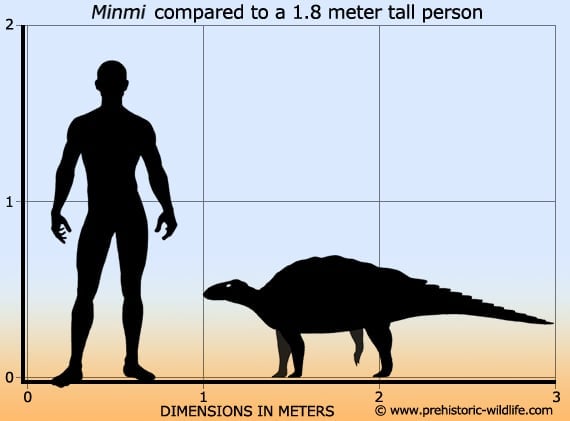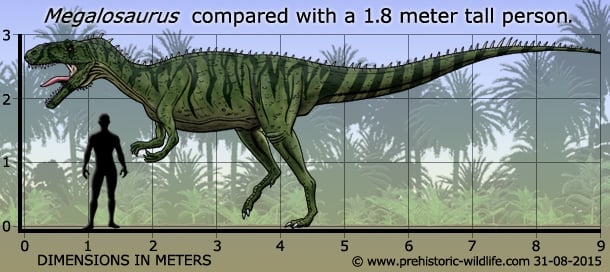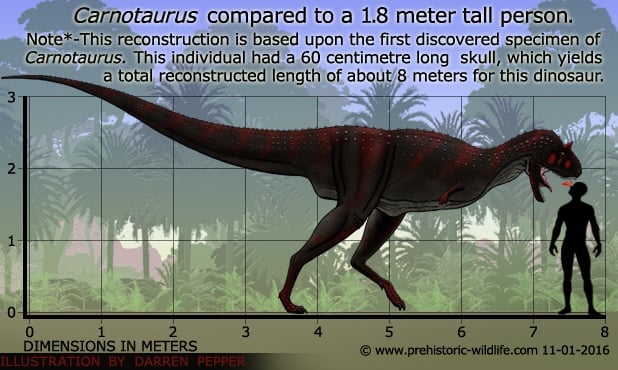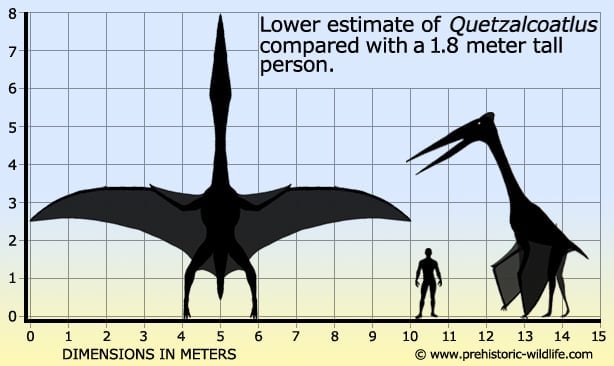|
|
Post by Talira Greycrest on Jun 16, 2021 5:30:37 GMT
My favourite Polacanthid: Name: GastoniaPronunciation: Gas-toe-nee-ah.Meaning of name: "Gaston's thing" after its discoverer, American palaeontologist, Robert Gaston.Species: G. burgei, G. lorriemcwhinneyaeSize: 5 metres long, 1.1 metres tall and weighing between 1 and 2 metric tonnes.Family: Polacanthinae (a sub-family of Nodosauridae).Diet: Herbivore. Fed on low-growing vegetation.First fossils found: Known from a number of specimens, the first of which were discovered in a bonebed in the Cedar Mountain Formation of Utah in 1989. G. burgei named in the same year by American palaeontologist, James Ian Kirkland. G. lorriemcwhinneyae named in 2016. The bonebed also contained the fossils of an Iguanodontid and the theropod, Utahraptor.Lived: 129.4 to 125 million years ago during the Barremian stage of the Early Cretaceous in what is now the western United States. |
|
|
|
Post by Talira Greycrest on Jun 16, 2021 13:35:19 GMT
My favourite Aussie dino: Name: MinmiPronunciation: Min-me.Meaning of name: Named after Minmi Crossing in Queensland, Australia, near where its fossils were discovered.Species: M. paravertebraSize: Between 2 and 3 metres long, 1 metre high and weighing around 300kgs.Family: Uncertain. Likely a Nodosaurid.Diet: Herbivore. Fed on low-growing vegetation.First fossils found: Known from two specimens, one of which is almost complete. First discovered by Australian palaeontologist, Alan Bartholomai, in the Bungil Formation of Queensland, Australia, in 1964. Named by Australian palaeontologist, Ralph Molnar, in 1980.Lived: 125 to 113 million years ago during the Aptian stage of the Early Cretaceous in what is now Queensland, Australia. |
|
Tix Mascot
Tech guru
Italy is my second homeland
Posts: 11,076  Mini-Profile Background: {"image":"http://4.bp.blogspot.com/-X5mhw13BJ7Y/TwKeZ3uM7YI/AAAAAAAABPw/D82go4Ny_8E/s1600/italy-background-8-787281.jpg","color":""}
Mini-Profile Text Color: 0ef8f1
Mini-Profile Name Color: f40d39
Year of Birth: 1961
Nationality: Norwegian
Mini-Profile Background: {"image":"http://4.bp.blogspot.com/-X5mhw13BJ7Y/TwKeZ3uM7YI/AAAAAAAABPw/D82go4Ny_8E/s1600/italy-background-8-787281.jpg","color":""}
Mini-Profile Text Color: 0ef8f1
Mini-Profile Name Color: f40d39
Year of Birth: 1961
Nationality: Norwegian
|
Post by Tix Mascot on Jun 16, 2021 15:43:22 GMT
I am constantly fascinated by their looks. This reminds me of a long-legged turtle with the head of a cobra.
|
|
|
|
Post by Joey12 on Jun 17, 2021 3:09:42 GMT
First thing I thought was turtle too but sure is taller and no shell. But the silhouette sure looks like one.
|
|
|
|
Post by Talira Greycrest on Jun 17, 2021 7:03:34 GMT
One of my favourite Hadrosaurs: Name: OlorotitanPronunciation: Ol-low-row-ti-tan.Meaning of name: "Giant swan", in reference to its long neck.Species: O. arharensisSize: Between 8 and 12 metres long, 4 metres tall (up to 6 metres tall when standing upright) and weighing 3 metric tonnes.Family: Lambeosaurinae (a sub-family of Hadrosauridae)Diet: Herbivore. Fed on both high and low-growing vegetation.First fossils found: Known only from a single, almost-complete skeleton discovered in the Udurchukan Formation of Far Eastern Russia between 1999 and 2000. Named by Belgian palaeontologist, Pascal Godefroit, in 2003. This animal's most striking feature is the large, hollow, hatchet-like crest on the head which is thought to have been used for display and vocal communication.Lived: 67 to 66 million years ago during the Maastrichtian stage of the Late Cretaceous in what is now Far Eastern Russia. |
|
|
|
Post by Talira Greycrest on Jun 17, 2021 13:24:48 GMT
This dino holds a very important place in the history of palaeontology as it was the very first dinosaur to be officially named: Name: MegalosaurusPronunciation: Meg-ah-low-sore-us.Meaning of name: "Great lizard".Species: M. bucklandiiSize: Estimated to have measured around 9 metres long, 3 metres tall and weighing around 1 metric tonne.Family: Megalosauridae.Diet: Carnivore.First fossils found: Known only from partial specimens. First discovered in a limestone quarry in Oxfordshire, southeast England, in 1676. Named by English palaeontologist, William Buckland, in 1824. Megalosaurus was the first non-avian dinosaur to be scientifically recognized. Seventeen years later, in 1841, English palaeontologist, Sir Richard Owen, coined the word 'dinosaur' which means "terrible lizard".Lived: 168 to 166.1 million years ago during the Bathonian stage of the Middle Jurassic in what is now southeast England.
 |
|
blitz
Level 2 Treasurer
Posts: 80
Mini-Profile Background: {"image":"https://img.wallpapic.de/i6436-537-911/thumb/donner-blitz-gewitter-natur-hintergrundbild.jpg"}
Mini-Profile Text Color: f8fafc
Mini-Profile Name Color: fcfcfc
|
Post by blitz on Jun 17, 2021 22:38:47 GMT
Sure is mega!
|
|
|
|
Post by Talira Greycrest on Jun 18, 2021 5:48:10 GMT
This dino is named after an airline company: Name: QantassaurusPronunciation: Kwan-tass-sore-us.Meaning of name: "Qantas lizard", after Qantas, Australia's national airline.Species: Q. interpidusSize: Unknown due to a lack of fossils.Family: Uncertain.Diet: Herbivore. Fed on low-growing vegetation.First fossils found: Known only from a few jaw fragments discovered in the Wonthaggi Formation of southeastern Victoria, Australia, in 1996. Named by Australian palaeontologists, Tom Rich, and his wife, Patricia, in 1999.Lived: 115 million years ago during the Aptian stage of the Early Cretaceous in what is now southern Australia.
 Qantassaurus jaw bone on display at my local museum Qantassaurus jaw bone on display at my local museum |
|
|
|
Post by Joey12 on Jun 18, 2021 6:41:57 GMT
Hope they keep looking there must be more in the area.
|
|
|
|
Post by Talira Greycrest on Jun 18, 2021 13:44:42 GMT
One of my favourite Theropods: Name: CarnotaurusPronunciation: Car-no-tore-us.Meaning of name: "Meat-eating bull", in reference to its bull-like horns.Species: C. sastreiSize: Between 7 and 9 metres long, 3 metres tall and weighing around 1.5 metric tonnes.Family: Abelisauridae.Diet: Carnivore.First fossils found: Known from a single, almost-complete skeleton with skin impressions, discovered in the La Colonia Formation of southern Argentina in 1984. Named by Argentinian palaeontologist, Jose Bonaparte, in 1985. The most striking features of this dino are the bull-like horns on its head and its incredibly short, completely useless, forearms.Lived: 72 to 69 million years ago during the Campanian and Maastrichtian stages of the Late Cretaceous in what is now southern Argentina. |
|
Tix Mascot
Tech guru
Italy is my second homeland
Posts: 11,076  Mini-Profile Background: {"image":"http://4.bp.blogspot.com/-X5mhw13BJ7Y/TwKeZ3uM7YI/AAAAAAAABPw/D82go4Ny_8E/s1600/italy-background-8-787281.jpg","color":""}
Mini-Profile Text Color: 0ef8f1
Mini-Profile Name Color: f40d39
Year of Birth: 1961
Nationality: Norwegian
Mini-Profile Background: {"image":"http://4.bp.blogspot.com/-X5mhw13BJ7Y/TwKeZ3uM7YI/AAAAAAAABPw/D82go4Ny_8E/s1600/italy-background-8-787281.jpg","color":""}
Mini-Profile Text Color: 0ef8f1
Mini-Profile Name Color: f40d39
Year of Birth: 1961
Nationality: Norwegian
|
Post by Tix Mascot on Jun 18, 2021 18:29:50 GMT
Looks like it's ready to bite the head off that poor guy. LOL
|
|
|
|
Post by Talira Greycrest on Jun 19, 2021 1:50:05 GMT
JW Fallen Kingdom Carnotaurus scene
|
|
|
|
Post by Talira Greycrest on Jun 19, 2021 5:17:49 GMT
|
|
|
|
Post by Joey12 on Jun 19, 2021 5:44:18 GMT
That's a strange one. Head looks like a duck and hump looks like a camel.
|
|
|
|
Post by Talira Greycrest on Jun 19, 2021 10:40:53 GMT
This animal is a Pterosaur and one of the largest flying animals to ever exist: Name: QuetzalcoatlusPronunciation: Kwet-zal-co-at-lus.Meaning of name: Named after Quetzalcoatl, the Aztec feathered serpent god.Species: Q. northropiWingspan: Estimated to have measured between 10 and 11 metres. Weighed between 200 and 250kgs.Family: Azhdarchidae.Diet: Carnivore.First fossils found: Known from at least four partial skeletons, the first of which was discovered by palaeontologist, Douglas A. Lawson, in Big Bend National Park, Texas, in 1971. Named by Mr. Lawson in 1975. Was originally thought to have had a wingspan of between 15 and 20 metres, however, studies have now lowered the estimated wingspan to 11 metres.Lived: 68 million years ago during the Maastrichtian stage of the Late Cretaceous in what is now the south-central United States. |
|